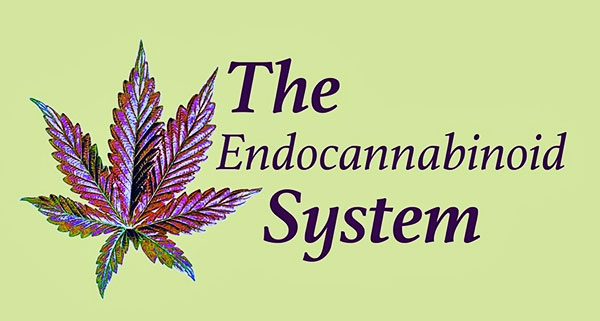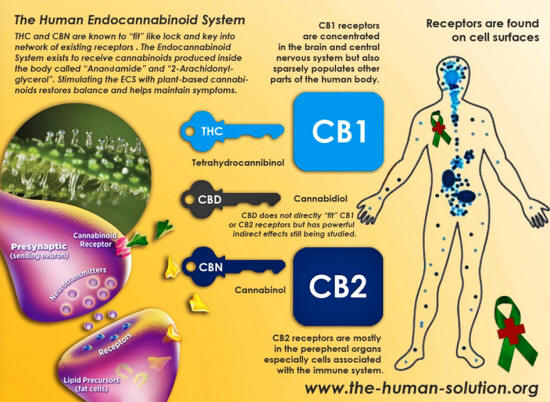|

by Mary Biles
August 20, 2017
from
WakeUpWorld Website

Did you know your body
has an endocannabinoid system? A year ago I didn't either...
I'm no doctor, but I thought I was familiar with the key biological
systems in the body. Turns out though, I was wrong. That's because
unless you're a research scientist or work in the field of medical
cannabis, it's unlikely you'll ever have been told about the
endocannabinoid system.
And yet, it has been
hailed as,
"the most important
physiologic system involved in establishing and maintaining
human health."
Why do so few
people know about the endocannabinoid system?
So what's the big mystery?
Well, it might have
something to do with how the endocannabinoid system (ECS)
was discovered.
Back in the 1990s
scientists were trying to understand how
THC, the psychoactive substance in the cannabis plant, elicits
its effect on the body.
What they uncovered
was a complex network of receptors (CB1) in the brain and central
nervous system that were a perfect fit for the
THC molecule.
Soon after another
type of receptor (CB2) was discovered in the immune system, gut and
many of the body's major organs.
But that was only
part of the puzzle. The hunt was on to find out whether the body
produced its own cannabis-like chemicals, and with the
identification of the first endocannabinoid
Anandamide, they had their
answer.
What does the
endocannabinoid system do?
What scientists
have realized is that the endocannabinoid system fine-tunes most of
our vital physiological functions, bringing balance to everything
from sleep, appetite, pain, inflammation, memory, mood and even
reproduction.
So in basic terms,
it's like a conductor of an orchestra, ensuring that no one section
is drowning out the other, with the end result a perfectly
harmonized symphony between body and mind.
Sounds like pretty
important work, right? Well, you'd be right. That's why it's vital
that the ECS becomes as much part of everyday parlance as the immune
system.
So to get the ball
rolling, here are some fascinating facts about the totally awesome
endocannabinoid system:

1. Humans
aren't alone in having an ECS
As humans
beings we're not special for having an ECS.
Not only is the
endocannabinoid system found in all vertebrates, but
scientists also discovered cannabinoid receptors in
non-vertebrate sea-squirts, suggesting an evolutionary process
dating back 600 million years ago.
2. CB1
receptors are the most abundant neurotransmitter receptors in
the brain
Most of us have
heard of neurotransmitters - they're the chemicals that
communicate information throughout the brain and body.
Serotonin and
dopamine are perhaps the most well known examples, but it's the
endocannabinoid Anandamide, also classed as a neurotransmitter,
that has
the most receptors in the brain.
3.
Endocannabinoids signal backwards
Most
neurotransmitters communicate in one direction: from the
signaling neuron to the postsynoptic neuron.
But in the
endocannabinoid system, it works in the opposite direction,
which is called
retrograde signaling. This
means that if a receptor is being over- or under-stimulated, it
signals backwards across the synapse telling the signaling
neuron to change its behavior, creating a kind of feedback loop.
So in effect,
rather than distributing information like other
neurotransmitters, it acts like a kind of dimmer switch, turning
activity up or down in order to return the body to homeostasis.
4. Increased
endocannabinoid system activity has been noted in many diseases
As the
endocannabinoid system's modus operandi is to bring balance to
the body, it's no surprise then that scientists have observed
elevated ECS activity in a number of illnesses.
Everything from
neurodegenerative diseases such
as Alzheimer's and Parkinson's, to
rheumatoid arthritis and
cancer, have shown changes in
endocannabinoid levels and greater receptor expression.
The conclusion
that has been most widely reached is that this increased
activity denotes the ECS trying to fulfill its role of returning
the body to equilibrium again.
5. 'Endocannabinoid
System Deficiency' may be a cause of some illnesses
But what
happens if the ECS becomes depleted?
Scientists have
observed how in certain conditions associated with
oversensitivity to pain such as migraines, fibromyalgia and IBS,
the ECS appears to have become weakened.
The theory is
known as
Clinical Endocannabinoid Deficiency,
with the corollary being that by supplementing the body with
compounds from the cannabis plant, this deficiency can be
corrected and the symptoms improved.
6. The ECS
explains why medicinal cannabis has a therapeutic effect
Prior to 20th
century prohibition, cannabis had been used for thousands of
years to treat a whole host of ailments from epilepsy,
headaches, arthritis, pain, depression and nausea.
Back then
nobody knew why the plant showed such therapeutic versatility.
The discovery of the endocannabinoid system soon shone new light
onto the medicinal effects of cannabis.
Sadly, this has
coincided with a time when the vast majority of the population
have been precluded from accessing it.
According to
Dustin Sulak, a leading
medical cannabis expert:
"Research has shown that small
doses of cannabinoids from cannabis can signal the body to
make more endocannabinoids and build more cannabinoid
receptors…
I believe that small, regular
doses of cannabis might act as a tonic to our most central
physiologic healing system."
7. You don't
have to break the law to give your endocannabinoid system a
boost
Currently,
medical cannabis-friendly countries are in the minority across
the planet.
So what can you
do if can't legally access the plant?
Well, you could
consider trying CBD, a non-psychoactive compound in the cannabis
plant, that has a whole host of health benefits such as
reducing inflammation,
calming feelings of anxiety,
and even lowering the
frequency of epileptic seizures.
CBD is normally extracted from
cannabis plants with less than 0.2% THC, commonly referred to as
hemp or industrial hemp, allowing it to be bought
legally in most countries worldwide.
Another option
is to peel yourself off the sofa and get moving. Scientists have
found that prolonged aerobic exercise
increases levels of the
feel-good endocannabinoid, Anandamide.
Diet is also a
useful target.
Increasing Omega 3 found in
oily fish or healthy seeds like flax or hemp, can help support
endocannabinoid brain signaling.
Leafy green
vegetables are also thought to stimulate the ECS as they contain
beta-caryophyllene which
activates the CB2 receptor.
8. Most
doctors know very little about the endocannabinoid system
With the ECS
playing such a central role in our health, you would think that
any self respecting member of the medical profession would have
some knowledge of its existence.
But in
mainstream medicine, the endocannabinoid system remains rather a
pariah. In 2013 a
survey was conducted asking
medical school in the United States whether the ECS formed part
of their curriculum.
The authors
found that only,
"13% teach
the endocannabinoid system to future doctors."
A lot can change in
four years, and while in some European countries such as the UK and
Spain the ECS does make it onto some medical school syllabuses, it
cannot be denied that the majority of professionals in charge of our
healthcare remain very much in the dark.
So now you're
endocannabinoid savvy, there's no turning back.
Join me and start
spreading the word to all that will listen. It's time that the ECS
is given the attention it deserves both by our healthcare providers
and the public at large.
If like me you feel
moved to take action,
You never know,
perhaps you are the very person to inform them.
| 


